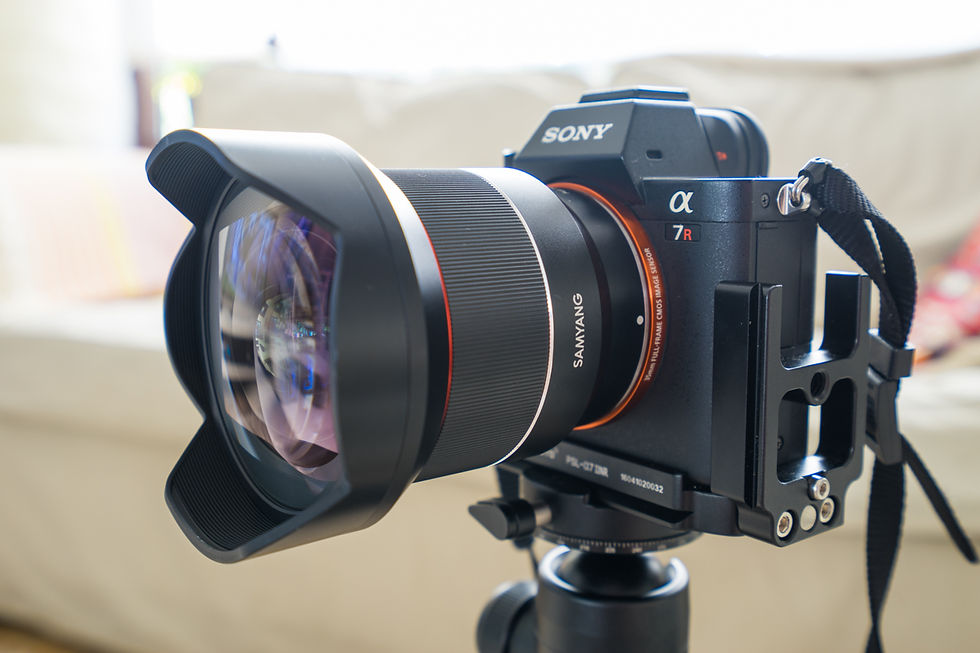
Samyang is showing some love for the E-mount by coming with 2 new lenses specifically designed for the Sony E-mount: The 50mm f/1.4 and the new 14mm f/2.8. The 14mm is interesting for me especially because the ‘old’ E-mount version (not specifically designed for mirrorless, basically a DSLR version with a built in adapter which makes it big’) was one of my favourite fast wide-angle primes because it was so sharp wide open at f/2.8.
As I only had this lens for a few days I will not go into too much details. Samyang also told me this was not a 100% final version. What I can do is give my first impressions and show some image samples. In this short ‘first impressions’ article I will compare the lens with the old version.
Looks


As can be seen in the photo the size of the new lens is much smaller than the old e-mount version. It also has a much more modern look than the old version. The look is very clean with clean fonts and a very big smooth focus ring. The whole scale display is stripped from the design and the focus ring turns unlimited. This is similar to the Zeiss Batis focusing for e-mount. You would have to check your focus scale and infinity on the digital bar on your camera display. The looks of the lens in general are of course subjective. I personally think the design is beautiful. The lens just looks very sexy on the A7 bodies:


A7RII with the Samyang 14mm f/2.8 FE attached.
Focusing
The focus ring focuses extremely smooth, a bit too smooth in my opinion. When using the lens in the field I had it change focus on numerous occasions when using manual focus because I touched the ring by accident. Of course, the main difference between this and the old version is the auto focus. The auto focus works fast and smooth and the autofocus motor is very silent.
Electronic connection
With the new version all of the EXIF data is being transferred to the camera body from the lens. This wasn’t the case with the old version.
Distortion
The old version was ‘famous’ for it’s extreme distortion that looks a bit like a moustache. With the new design of the new lens the distortion has greatly improved. The moustache is gone. The lines are still slightly curved because of the big curved front element but this is easily fixed with a lens profile. In fact: By using the Sony FE 16-35 f4 lens profile in Lightroom it corrected the images very well. An ‘official’ lens profile was not available yet at the time of writing this article. Here’s a little comparison:



Sunstar
The sunstar of the old version wasn’t great at f/22. The new one is better and has more character. It’s still not one of the best. Look of sunstars is of course subject to personal opinion. Here’s an example of the new sunstar shot at f/22:

Sharpness
The old Samyang 14mm f/2.8 was one of my favourite wide angle primes because it was so sharp wide open. I wasn’t that impressed by the sharpness of the new version. However, when I tried another version of the same lens at Photokina it was considerably sharper wide open. It still didn’t beat the old version though, but it was definitely better than the copy I tried out at first. Note that the copy I had was not a final version and was still a prototype.
Summarised:
- The new version is much smaller than the old one.
- The new version looks much better (subjective).
- Full EXIF transfer to the camera body.
- Autofocus, that works well and is very silent.
- Manual focus with a big that ring turns unlimited. You have to check the focus distance/infinity on the camera display.
- No focus distance display on the lens.
- Distortion is greatly improved compared to old one: moustache distortion is gone.
- Better sunstar (subjective).
- Less vignetting on especially wider apertures.
- Less sharp than the old one, especially wide open (I had a prototype).
Conclusion so far
The new Samyang 14mm f/2.8 designed for E-mount beats the old version in almost every aspect AND it has auto focus that could be important for some people. If you’re looking for a good fast wide-angle prime than this lens is currently a good bet, especially if you’re looking at the price. If you plan on using the lens for only astrophotography landscapes than the old one might be a better choice because of the better sharpness wide open. Again, a prototype was used for this review.
This is all I can say about the lens for now. Stay tuned for a full review that will be coming somewhere in October probably.
Gear used in this review:
Some more samples images (all taken with Sony A7RII):






